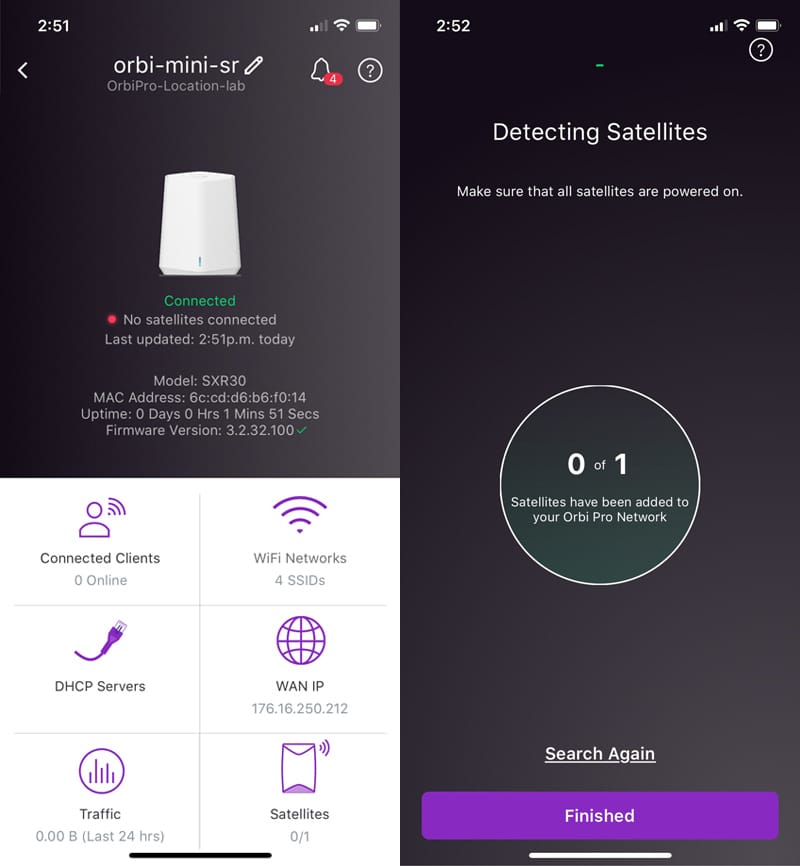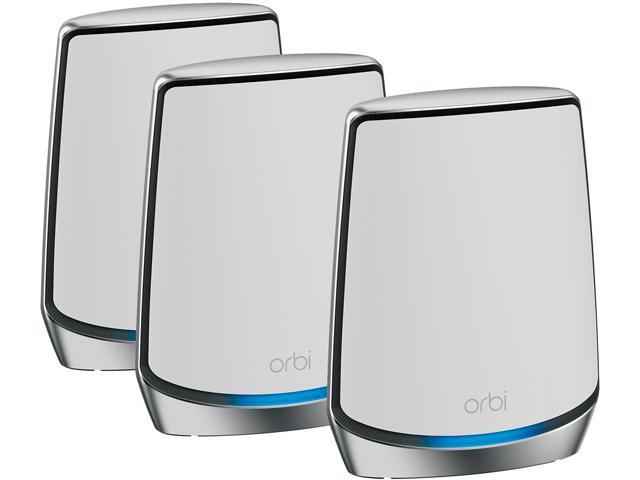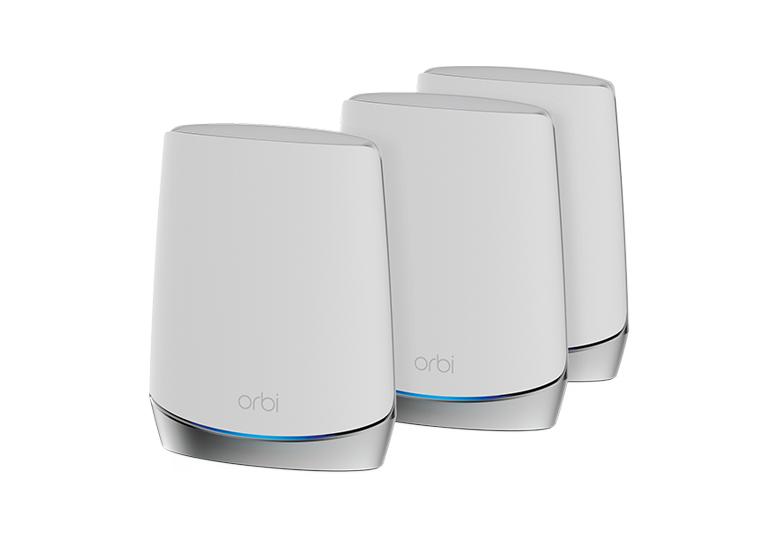Orbi Wifi 6 Review

Netgear Orbi Wifi 6E Review: Performance
The Orbi WiFi 6E’s feature set may be strong, but its real selling point is performance. This was tested by setting up an Orbi router at home in my bedroom and placing the satellite nodes near my house, as suggested by the app. Then, I carried my laptop around the house to measure file transfer speeds from and to a shared folder. This was connected over an Ethernet link of 2.5Gbits/sec to the Orbi router.
Because almost all client hardware is still using 5GHz, I started by testing performance with my HP notebook, which has an Intel AX200 2×2 WiFi 6 card. Here are the speeds I saw:
The power of a three-station mesh system with a dedicated backhaul band is plain to see. The Orbi WiFi 6E’s download speeds were overall on a par with Netgear’s previous flagship Orbi, the Wi-Fi 6-equipped RBK852, and a step up from the two-node Asus system and the dual-band eero.
Upload rates weren’t as consistent as usual. This is likely due to the router as well as client hardware. The Orbi 6E was not a failure. It delivered a minimum 13.8MB/sec downstream, even in the most difficult-to-reach areas of the house.
However, performance at 5GHz is just one part. Testing performance on the 6GHz band meant upgrading my test laptop, but this was surprisingly easy: I was able to order an Intel AX210 Wi-Fi 6E card online for less than PS40, and it took me barely five minutes to open up my laptop, slot in the card, snap on the antenna connectors and screw everything back up. This won’t be possible with every laptop, but even on systems whose RAM and storage are hard-wired the network card is sometimes user-replaceable.
With my new card in place, I repeated my tests. I was initially dubious as to how much benefit I’d see from switching to the 6GHz range, especially since – although Netgear doesn’t openly advertise the fact – Orbi systems use an 80MHz channel width rather than the maximum 160MHz. The results were amazing!
It’s clear that 6GHz performance is a game-changer. In every room of the house the Orbi 6E gave me significantly higher download speeds than I’ve ever seen before. The connection speed was twice that of a Wi-Fi router in the bedroom and study. It also beat a wired Gigabit Ethernet at 105 MB/sec. Although speeds dropped in more difficult locations, Orbi WiFi 6E was still a great choice. Upload performance was also excellent.
Netgear – Buy Now

Prices
Netgear offers the Orbi Pro WiFi 6 Mini in two versions. One is a standalone router, while the multi-part package includes additional satellites that provide greater coverage.
Surprisingly, the Amazon Black Friday Deal has one router (SXR30), which costs PS188.82 ($169.99), while a dual-pack with one satellite (SXK30), only PS181.99 ($195.72). Triple packs with 2 satellites (SXK30B3) cost PS244.99 (329.99), while additional satellites (SXS30), are available for PS172.82 (158.23).
This pricing shows that the dual pack is the most affordable package, unless you are looking for a router with two satellites.
To put that in perspective, the Netgear Orbi Pro WiFi 6 dual pack (SXK80) is PS708.99 ($729.99), making the Mini something of a bargain in comparison.
For our testing, we received the dual pack with a single satellite (SXK30) for this review.
This hardware is smaller in scale than the Netgear Pro WiFi 6, (SXK80), which has a larger price tag.
The router and the satellites in the SXK80 tower at 24.6cm (9.7inches) tall. They are also impossible to miss once they have been mounted using the brackets provided.
The SXR30 router (and the SXS30 satellite, which are combined are known as the SXK30), are smaller at 18.9cm (7.4inches) and less impressive than the SXR30 router.
Similar, L-shaped plastic wall-mounts are attached to the wall prior to the satellite or router. Then they are screwed on. We liked that these don’t merely clip them to the mounts, as it should ensure that they can’t be easily knocked off or stolen.
The two pieces look almost identical from the outside. The only significant difference between the router and satellite is that the four Ethernet ports on the router include a single WAN port to connect to the Internet broadband modem. All four satellite ports are used to distribute a wired network.
As with most MESH wireless configurations, it is possible to extend the network by connecting the satellites using purely wireless communication or by providing a wired backbone.
This option is different from the SXK80’s hardware in that it had Ethernet switch components that were link-aggregated and capable of 2.5 GbE Ethernet. However, these features are absent from the SXK30.
Therefore, the best backchannel performance of the Mini might be over WiFi since the maximum of a single Ethernet line is just 1Gbit. But, as we’ll see later, for other reasons that might not be a good idea.
That’s a slight change, but the big differences are inside, where Netgear have dramatically reduced the amount of wireless technology available.
The SXK80 had tri-band 4×4 AX6000 operations, but the SXK30 has dual-band operation and AX1800 only. Broadband bandwidth has been reduced by half on 5GHz and 2.5GHz. There are now two channels and the backhaul at 5GHz is shared between users, not one.
With less than a third of the potential bandwidth to share around, the SXK30 can’t effectively handle the same number of users as the SXK80 or provide the same coverage.
Because the backhaul doesn’t have a dedicated 5GHz channel, installing an Ethernet line to provide this data pathway is converted as an option on the SXK80 to a practical necessity on the SXK30.
This would be a complete disservice to MESH wireless networking. However, the Mini’s limited bandwidth might make it the most effective policy.
For that small number, maybe up to 10 users, the performance they will experience will match that of the much more expensive option, as each will only be taking a modest amount of the 1800Mbps available. And, on the SXK80, additional bandwidth can’t be easily allocated to each user even if the overall pool is greater.
Where the SXK80 can handle a building space of up to 18,000 square feet with a maximum of six satellites, the SXK30 can also connect to six satellites but only covers 6,000 square feet. A retail or office space of 77 feet square can still be a great size, unless the business has a larger workshop or production area.
How this translates into vertical connections is dependent on how the floors are constructed and, if they are concrete, how much metal reinforcement they might contain. But, for a typical European home three vertical floors should be adequately covered.
The Mini, like its older brother the Mini utilizes the Netgear Mobile Application for Configuration and not the Netgear Orbi Tool that was intended for older hardware.
From our point of view, Insight has a couple problems. The first is that it is too complicated to administer in a situation where there is no other Netgear equipment.
A second reason is that you will need an annual subscription to access the most advanced features. You get one month of premium membership free when you buy a new device. Once that gratis period is exhausted, using the premium features comes with an additional ongoing cost.
You can get more Netgear hardware for less, but it’s not something you should be using unless it is essential to your daily management.
Another caveat to Insight is that nothing it does is typically instantaneous. Our Mini router configuration took us 20 minutes. Each step refers to centralised control by Insight servers.
A web interface is available to you, eliminating the need for Insight if it’s not your preference.
The web interface might be the best choice, as we had some issues with Insight when we tried to install the router as an Access Point and not a router, which is an option.
Except without it operating as the only router on a network, it has trouble accessing the internet and switching it to AP mode proved to be far from easy. We were able to convince the hardware that it was not the DHCP server. It could still play nicely with other hardware, but it wasn’t a simple plug-and-play situation.
Slightly offsetting the pedantic nature of these mechanisms, adding satellites to a router is merely a matter of connecting them within wireless connection range or on the same wired network, and they’ll automatically be found and added. Insight sees the Orbi Pro router and its satellites as a single entity, making that part of controlling them remarkably straightforward.
Another excellent feature is the units ability to support four different SSIDs.
Being able to segment administration, employees, IoT and Guests, as an example, is useful for those that like to give customers internet access or limit the functionality available to some staff.

11Ac And Wifi 6 At 5Ghz
We ran the 802.11ax WiFi 6 test alongside the 802.11ac one so you can see the performance benefit from the new standard.
Within 1m, the NETGEAR OrbiAX6000 puts up a good showing with 802.11ac, hitting 546Mbits/sec, which is amongst the best close range results we’ve seen. But in WiFi 6 mode, the bandwidth increases to 707Mbits/sec, which is on par with the non-mesh WiFi 6 NETGEAR Nighthawk AX12. If this resonated with you, you might also enjoy
Google Wifi Ac1200 Review
At 5m, the AX6000 is the best 802.11ac router we’ve seen, hitting 448Mbits/sec. But in WiFi 6 mode, performance has only dropped 10 per cent from 1m, achieving an even more impressive 635Mbits/sec. At 10m there is no difference between 802.11ac or ax. The AX6000 achieves 461Mbits/sec while the AX6000 manages 463Mbits/sec – these are both incredible performances.
These 15m results show a similar feat, with 802.11ac bandwidth at an incredible 451Mbits/sec. This is far more than any other mesh system that we have tested. WiFi 6 results are even more impressive, at 542Mbits/sec.
At 20m the 802.11ac bandwidth drops to normal, at a mere 107Mbits/sec. However, WiFi 6 throughput remains at 376Mbits/sec. Moving out to 25m, the 801.11ac speed has dropped to a merely usable 18.9Mbits/sec. But WiFi 6 bandwidth is still at an incredible 86.4Mbits/sec, and it scarcely drops at a further 5m out to 30m, where it achieves 83.2Mbits/sec. Unfortunately, 802.11ac speed has dropped to just 5.87Mbits/sec.
Although the AX6000 could not deliver 802.11ac at 32m distance “behind shed”, the WiFi 6 signal still worked strong and provided 27.6Mbits/sec.
These are amazing results overall. While you won’t get an additional 802.11ac range, these devices still deliver incredible performance at 20m. WiFi 6’s range and performance are also outstanding. However, WiFi 6 is the most powerful WiFi available with best coverage in the area.

Netgear Orbi 6-Band Dual-Band Mesh (Rbk353) Design and Setup – It’s Simple and Easy to Get Started With The Orbi Application
- Orbi App guides you through installation
- New routers and satellites are very small
- A decent number of Ethernet ports
The Orbi WiFi 6, which was an extremely large product, is now much more compact than the RBK353. The box contains one router, two satellites and a charger. However, the RBK353 has two satellites for less. The device comes in a compact box measuring 178x145x61mm. They’re easy enough to position where you want them.
The router needs to be connected to your internet modem via its Gigabit Ethernet WAN port. Note that you don’t get the faster 2.5Gbit/s port that you get with the more expensive Orbi system. Even so, it’ll be some time before UK internet speeds reach a point that this connection is a bottleneck.
You also get three Gigabit Ethernet ports for connecting devices, which gives you a fair amount of scope.
The Satellites are physically identical but have 2 Gigabit Ethernet ports. That’s one more than on the Netgear Nighthawk Mesh WiFi 6 system. Not only can you connect more devices to the satellites, but there’s one added bonus: if you decide to connect the Orbi satellites together via Ethernet, you still have a spare port.
If you were into this, you might also like
Best Mesh Wifi System
For most people, the Orbi system will be configured in wireless mode, with the router and satellites communicating via Wi-Fi 6.
Setup is via the Netgear Orbi app, which takes you through placing the router, connecting it to your internet and getting the satellites in place. You will have your wireless network up and running in no time.

Netgear Orbi Wifi 6 Dual-Band Mesh System (Rbk353) Performance – Reliable Speeds And Good At Range
The Wi-Fi 6 baby runs the dual-band AX1800 network. This means there is no separate wireless network to allow communication between satellites. Instead, clients and network communication needs to share the two networks.
You can see a 2-stream network at 5GHz running at up 1.2Gbps, and a 2-stream network at 2.4GHz running at 600Mbps. Streams are important with Wi-Fi 6, as they can be thought of as individual networks. You can connect four devices to your router and each one will get its own bandwidth. Alternatively, a multi-stream device can use multiple streams, say sucking up all of the 5GHz band available.
There are four streams for each device. This means that you have 12 streams all around your house. If you place your satellites well, then, you get a fair amount of bandwidth per device. Wi-Fi 6 can be used backwards with Wi-Fi 5, but you will lose some speed and bandwidth sharing.
Putting the router through my usual throughput tests, I first of all set up with the router downstairs and one satellite upstairs. This setup is identical to the Orbi RBK352 cheaper system. Here, the Orbi did well. Close to the router, with a Wi Fi 6 laptop, I was able to get throughputs up 417.59 Mbit/s. On the first floor, my throughput dropped to 199.87, while on the second floor I was able to get throughputs as high as 188.64Mbit/s.
This is very comparable performance to Netgear Nighthawk WiFi 6 System, as shown in the graph.
If you were a fan of this, you might also appreciate
Netgear Nighthawk Ax1800 Review
Compared to RBK852 and this new system is a fair way behind. Although the Orbi is more powerful and has more channels, it’s also more costly. It has to be said that the older Wi-Fi 5 Orbi products, which have a dedicated backhaul do better on the first floor in my house, although they struggle at greater range.
The third satellite allowed me to receive reception even in my kitchen which is usually very poor. Here, I got throughputs of 174.25Mbit/s. The new Orbi RBK853 performs well for the cost.

